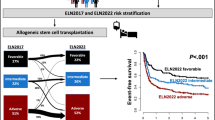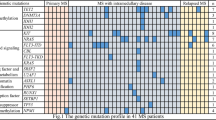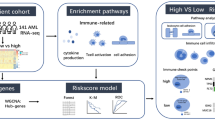Abstract
The SMAD family (SMAD1-9) was critically important for regulating cellular process through transforming growth factor-β signaling pathway, and contributed to carcinogenesis; however, their prognostic roles in acute myeloid leukemia (AML) remained unclear. This study collected 84 de novo AML patients treated with chemotherapy and 71 patients who underwent allogeneic hematopoietic stem cell transplantation (allo-HSCT). Kaplan–Meier survival estimate indicated that among SMAD1-9, high SMAD3 and SMAD7 expression were both associated with poor event-free survival (EFS) and overall survival (OS; all P < 0.05) in AML patients undergoing chemotherapy; and high SMAD6 expression was associated with shorter EFS and OS (all P < 0.01) in patients underwent allo-HSCT. Multivariate analysis showed that only high SMAD7 expression had adverse effect on EFS and OS (P = 0.021, 0.026) independently. Furthermore, High SMAD3 and SMAD7 expressers had significantly shorter EFS and OS than low expressers (P = 0.006, 0.001). In AML patients who went through allo-HSCT, there were no significant differences for EFS and OS between patients with high and low-expression SMAD3 or SMAD7. Our study suggested that high expression of SMAD3 and SMAD7 predicted adverse prognosis in AML patients undergoing chemotherapy and SMAD7 was a better prognostic marker than SMAD3. Their prognosis impact may be overcome by allo-HSCT.
This is a preview of subscription content, access via your institution
Access options
Subscribe to this journal
Receive 12 print issues and online access
$259.00 per year
only $21.58 per issue
Buy this article
- Purchase on Springer Link
- Instant access to full article PDF
Prices may be subject to local taxes which are calculated during checkout



Similar content being viewed by others
References
Dohner H, Weisdorf DJ, Bloomfield CD. Acute Myeloid Leukemia. N Engl J Med. 2015;373:1136–52.
Dohner H, Estey E, Grimwade D, Amadori S, Appelbaum FR, Buchner T, et al. Diagnosis and management of AML in adults: 2017 ELN recommendations from an international expert panel. Blood. 2017;129:424–47.
Dohner H, Estey EH, Amadori S, Appelbaum FR, Buchner T, Burnett AK, et al. Diagnosis and management of acute myeloid leukemia in adults: recommendations from an international expert panel, on behalf of the European LeukemiaNet. Blood. 2010;115:453–74.
Tsai CH, Hou HA, Tang JL, Liu CY, Lin CC, Chou WC, et al. Genetic alterations and their clinical implications in older patients with acute myeloid leukemia. Leukemia. 2016;30:1485–92.
Thol F, Damm F, Ludeking A, Winschel C, Wagner K, Morgan M, et al. Incidence and prognostic influence of DNMT3A mutations in acute myeloid leukemia. J Clin Oncol. 2011;29:2889–96.
Meyer SC, Levine RL. Translational implications of somatic genomics in acute myeloid leukaemia. Lancet Oncol. 2014;15:e382–94.
Sanders MA, Valk PJ. The evolving molecular genetic landscape in acute myeloid leukaemia. Curr Opin Hematol. 2013;20:79–85.
Mendler JH, Maharry K, Radmacher MD, Mrozek K, Becker H, Metzeler KH, et al. RUNX1 mutations are associated with poor outcome in younger and older patients with cytogenetically normal acute myeloid leukemia and with distinct gene and MicroRNA expression signatures. J Clin Oncol. 2012;30:3109–18.
Patel JP, Gonen M, Figueroa ME, Fernandez H, Sun Z, Racevskis J, et al. Prognostic relevance of integrated genetic profiling in acute myeloid leukemia. N Engl J Med. 2012;366:1079–89.
Derynck R, Zhang YE. Smad-dependent and Smad-independent pathways in TGF-beta family signalling. Nature. 2003;425:577–84.
Jiang Y, Liang H, Guo W, Kottickal LV, Nagarajan L. Differential expression of a novel C-terminally truncated splice form of SMAD5 in hematopoietic stem cells and leukemia. Blood. 2000;95:3945–50.
Hata A, Chen YG. TGF-beta signaling from receptors to Smads. Cold Spring Harb Perspect Biol. 2016;8:a022061.
Wang N, Kim HG, Cotta CV, Wan M, Tang Y, Klug CA, et al. TGFbeta/BMP inhibits the bone marrow transformation capability of Hoxa9 by repressing its DNA-binding ability. EMBO J. 2006;25:1469–80.
Sing GK, Keller JR, Ellingsworth LR, Ruscetti FW. Transforming growth factor beta selectively inhibits normal and leukemic human bone marrow cell growth in vitro. Blood. 1988;72:1504–11.
Quere R, Karlsson G, Hertwig F, Rissler M, Lindqvist B, Fioretos T, et al. Smad4 binds Hoxa9 in the cytoplasm and protects primitive hematopoietic cells against nuclear activation by Hoxa9 and leukemia transformation. Blood. 2011;117:5918–30.
Witkowska M, Majchrzak A, Cebula-Obrzut B, Wawrzyniak E, Robak T, Smolewski P. The distribution and potential prognostic value of SMAD protein expression in chronic lymphocytic leukemia. Tumour Biol. 2017;39:1010428317694551.
Matveeva A, Kovalevska L, Kholodnyuk I, Ivanivskaya T, Kashuba E. The TGF-beta - SMAD pathway is inactivated in cronic lymphocytic leukemia cells. Exp Oncol. 2017;39:286–90.
David CJ, Massague J. Contextual determinants of TGFbeta action in development, immunity and cancer. Nat Rev Mol Cell Biol. 2018;19:419–35.
Chruscik A, Gopalan V, Lam AK. The clinical and biological roles of transforming growth factor beta in colon cancer stem cells: a systematic review. Eur J Cell Biol. 2018;97:15–22.
Hernanda PY, Chen K, Das AM, Sideras K, Wang W, Li J, et al. SMAD4 exerts a tumor-promoting role in hepatocellular carcinoma. Oncogene. 2015;34:5055–68.
Brown KA, Pietenpol JA, Moses HL. A tale of two proteins: differential roles and regulation of Smad2 and Smad3 in TGF-beta signaling. J Cell Biochem. 2007;101:9–33.
Ellenrieder V. TGFbeta regulated gene expression by Smads and Sp1/KLF-like transcription factors in cancer. Anticancer Res. 2008;28:1531–9.
Zhao Y, Ma J, Fan Y, Wang Z, Tian R, Ji W, et al. TGF-beta transactivates EGFR and facilitates breast cancer migration and invasion through canonical Smad3 and ERK/Sp1 signaling pathways. Mol Oncol. 2018;12:305–21.
Itoh Y, Saitoh M, Miyazawa K. Smad3-STAT3 crosstalk in pathophysiological contexts. Acta Biochim Biophys Sin (Shanghai). 2018;50:82–90.
Datta PK, Moses HL. STRAP and Smad7 synergize in the inhibition of transforming growth factor beta signaling. Mol Cell Biol. 2000;20:3157–67.
Boldbaatar A, Lee S, Han S, Jeong AL, Ka HI, Buyanravjikh S, et al. Eupatolide inhibits the TGF-beta1-induced migration of breast cancer cells via downregulation of SMAD3 phosphorylation and transcriptional repression of ALK5. Oncol Lett. 2017;14:6031–9.
Chen J, Mu Q, Li X, Yin X, Yu M, Jin J, et al. Homoharringtonine targets Smad3 and TGF-beta pathway to inhibit the proliferation of acute myeloid leukemia cells. Oncotarget. 2017;8:40318–26.
Gupta V, Tallman MS, Weisdorf DJ. Allogeneic hematopoietic cell transplantation for adults with acute myeloid leukemia: myths, controversies, and unknowns. Blood. 2011;117:2307–18.
Buccisano F, Hourigan CS, Walter RB. The prognostic significance of measurable (“Minimal”) residual disease in acute myeloid leukemia. Curr Hematol Malig Rep. 2017;12:547–56.
Cheng Z, Zhou L, Hu K, Dai Y, Pang Y, Zhao H, et al. Prognostic significance of microRNA-99a in acute myeloid leukemia patients undergoing allogeneic hematopoietic stem cell transplantation. Bone Marrow Transplant. 2018 https://doi.org/10.1038/s41409-018-0146-0 [e-pub ahead of print].
Jung SM, Lee JH, Park J, Oh YS, Lee SK, Park JS, et al. Smad6 inhibits non-canonical TGF-beta1 signalling by recruiting the deubiquitinase A20 to TRAF6. Nat Commun. 2013;4:2562.
Liu YC, Hsiao HH, Lin PM, Yang WC, Chang CS, Liu TC, et al. Prognostic implication of molecular aberrations in cytogenetically normal acute myeloid leukemia patients receiving allogeneic hematopoietic stem cell transplantation. Genet Mol Res. 2013;12:5414–23.
Zhang J, Shi J, Zhang G, Zhang X, Yang X, Yang S, et al. BAALC and ERG expression levels at diagnosis have no prognosis impact on acute myeloid leukemia patients undergoing allogeneic hematopoietic stem cell transplantation. Ann Hematol. 2018;97:1391–7.
Acknowledgements
We are grateful to the Cancer Genome Atlas (TCGA) database for their sharing of data.
Funding
This work was supported by grants from the National Natural Science Foundation of China (81500118, 61501519), the China Postdoctoral Science Foundation funded project (Project No.2016M600443), PLAGH project of Medical Big Data (Project No.2016MBD-025), and Beijing Natural Science Foundation (7164310).
Author information
Authors and Affiliations
Corresponding author
Ethics declarations
Conflict of interest
The authors declare that they have no conflict of interest.
Electronic supplementary material
Rights and permissions
About this article
Cite this article
Zhang, J., Zhang, L., Cui, H. et al. High expression levels of SMAD3 and SMAD7 at diagnosis predict poor prognosis in acute myeloid leukemia patients undergoing chemotherapy. Cancer Gene Ther 26, 119–127 (2019). https://doi.org/10.1038/s41417-018-0044-z
Received:
Revised:
Accepted:
Published:
Issue Date:
DOI: https://doi.org/10.1038/s41417-018-0044-z



